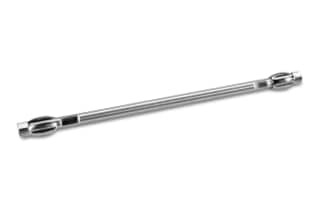
|
Chemistry |
Amide |
|
Separation Mode |
Hydrophilic Interaction (HILIC) |
|
Particle Substrate |
Hybrid |
|
pH Range Min |
2 pH |
|
pH Range Max |
11 pH |
|
Maximum Pressure |
6000 psi (415 Bar) |
|
Endcapped |
No |
|
Silanol Activity |
Low |
|
Particle Shape |
Spherical |
|
Particle Size |
3.5 µm |
|
Endfitting Type |
Waters |
|
Pore Size |
130 Å |
|
Format |
Column |
|
Surface Area |
185 |
|
System |
HPLC |
|
Particle Technology |
BEH |
|
USP Classification |
L68 |
|
Inner Diameter |
2.1 mm |
|
Length |
150 mm |
|
Carbon Load |
12 % |
|
UNSPSC |
41115709 |
|
Brand |
XBridge |
|
Product Type |
Columns |
|
Units per Package |
1 pk |
XBridge BEH Amide Column, 130Å, 3.5 µm, 2.1 mm X 150 mm, 1/pk
The XBridge Amide Columns are designed on Waters' Ethylene Bridged Hybrid (BEH) particle technology that offers a chemically stable, tri-functionally bonded amide phase which produces stability and versatility in HILIC separations. The XBridge Columns are designed to maximize productivity, and the XBridge Column has the same selectivity as the ACQUITY UPLC BEH Amide Column, which enables scientists to have seamless transfer separations between HPLC and UPLC technology platforms.
The XBridge BEH Amide Column was specifically designed to retain polar analytes and metabolites that are too polar to retain via reversed-phase chromatography. With a wide pH range of the mobile phase from 2 to 11, the XBridge BEH Amide Column provides exceptional retention of polar analytes spread over a wide variety of structural moiety, pKa, and polarity.
The XBridge BEH Amide Column listed here is particularly well suited for the analysis of carbohydrates with the 3.5 µm particle size, 130Å pore size, and the column can support a carbon load of 12%. This enables high resolution and high-speed analysis in complex sample matrices while maintaining or improving the chromatographic resolution.
The XBridge BEH Amide Column is manufactured under the strictest of controls to ensure the highest industry standards are met. This allows us to create lab equipment you can rely on and enables you to be able to have reproducible results batch over batch. You can increase your productivity with the ideal lab equipment. To learn more about the variations of the same product, such as the XBridge BEH Amide Column, or to find additional products that work with it check out our shop for lab equipment; you can browse through our website, refer to our catalog and ensure your lab needs are met as needed.
We also highly recommend you check out the XBridge BEH Amide VanGuard Cartridge, 130Å, 3.5 µm, 2.1 mm X 5 mm, 3/pk, which was designed to extend analytical column lifetime and performance by removing particulate contamination from the mobile phase stream. This specific cartridge is optimized to protect all 2.1 mm and 3.0 mm I.D. XBridge BEH Amide analytical columns containing 3.5 µm sorbent particles.
What Is The Importance Of Resolution In Chromatography?
Resolution in chromatography is determined by the peak width and retention time, both of which are inherent characteristics of the chromatographic process. By assessing resolution measurements, one can effectively optimize separations. Peak width, representing the spread of analyte peaks, directly influences the degree of separation between components. A narrower peak width signifies higher resolution. Retention time, on the other hand, denotes the time a particular analyte spends in the stationary phase. By manipulating parameters that affect peak width and retention time, such as column selection, mobile phase composition, and operating conditions, chromatographers can fine-tune the resolution and achieve optimal separation of analytes. This enables accurate identification and quantification of individual components within complex mixtures, enhancing the overall performance and reliability of chromatographic analyses.
What Is The Maximum Pressure And pH Range The XBridge BEH Amide Column Can Operate Within?
The XBridge BEH Amide Column can tolerate operating pressures up to 6000 psi (or 415 Bar), along with the pH range of 2 to 11. But if you are working at extremes of pressures, pH, and/or temperatures, this can drastically impact column efficiency and lifetime.